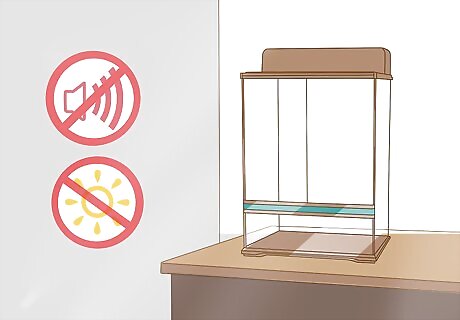
views
X
Research source
Having a chameleon as a pet, however, is not for the novice reptile owner. If you are thinking about buying a chameleon, make sure you know what you are getting into before making the purchase.
Buying a Chameleon

Determine if you are ready to buy a chameleon. Chameleons can be relatively high-maintenance animals. Before you buy a chameleon, determine if you are ready to make the commitment to own one. You can start by learning what it costs to own a chameleon—one year of care (e.g., food, supplies, veterinary care) can cost between $900 and $1200. Look at your current budget to see if you can factor in an extra $100 per month for chameleon care. A chameleon’s cage can take a fair amount of energy to set up and maintain. For example, the humidity and temperature of a chameleon’s cage should be monitored on a daily basis. The cage also needs to contain plenty of branches foliage that the chameleon can respectively climb and munch on. Consider talking with a chameleon expert or someone who owns a chameleon to have a better idea of what is involved in owning and caring for a chameleon.

Select a reputable pet store or breeder. Buying your chameleon from a reputable pet store or breeder will help ensure that he is healthy. A veterinarian who specializes in exotic veterinary medicine could provide you with recommendations on respectable chameleon breeders. If there are reptile shows in your area, you could visit one of the shows to identify breeders or ask for breeder recommendations. Reptile magazines can also provide information on chameleon breeders. Find out if your local pet store sells chameleons. If not, the staff at the store could possibly provide you with information on other quality pet stores that sell chameleons.

Purchase a captive-bred chameleon. Compared with wild-caught chameleons, captive-bred chameleons are healthier, less stressed, and less likely to carry a heavy parasite burden. In addition to having more parasites, wild-caught chameleons are usually more dehydrated than those that are captive-bred. It is illegal to capture and transport wild chameleons. Shipping wild chameleons can result in shortened lifespans in captivity and increased rates of mortality during shipping. A reputable pet store or chameleon breeder should not be involved in the capture or transport of wild chameleons. Wherever you purchase your chameleon, verify that he was bred in captivity and not captured in the wild. Among chameleon species, veiled chameleons and panther chameleons are most likely to be captive bred.

Purchase a young chameleon. Chameleons vary in their longevity, but most live between a few years and 10 years of age. Buying a young chameleon will increase the amount of time you could keep him as a pet.

Check the chameleon for signs of illness. A reputable breeder or pet store should be able to give you a full medical history of the chameleon you intend to purchase. However, you should look the chameleon over yourself to make sure he is healthy before you purchase him. Check his eyes—sunken eyes are an indicator of dehydration. Closed eyes in the daylight indicates general malaise in chameleons. If the chameleon’s color is dark or drab, he is either stressed, sick, or cold. A chameleon with bone abnormalities (e.g., curved back, swollen jaw, bowlegged stance) likely has a metabolic bone disease due to calcium deficiency. If you notice cheesy material or a green color in the chameleon’s mouth, he may have a bacterial infection called ‘mouth rot.’ Chameleons do not like being handled. If the chameleon you intend to purchase does not resist being held (e.g., hissing, gaping mouth), he is likely sick. To ensure the chameleon is healthy, the breeder or pet staff may perform routine fecal exams on him and administer prophylactic deworming. Do not purchase a chameleon who is sick.

Do not purchase a chameleon through the mail. You should avoid a mail-order purchase of your chameleon for several reasons. First, chameleons tend not to fare well when shipped. Shipping is very stressful for them, which could cause them to get very sick (or even die) during transport. Also, ordering a chameleon through the mail does not allow you to see him before he gets to you. You may not know until it is too late that he is sick or injured.
Preparing Your Chameleon’s Habitat

Select a cage type and size for your chameleon. Prepare your chameleon’s habitat before you bring him home. In fact, you could even start on this after you have decided to buy a chameleon. Chameleons grow quickly, so you will need to buy a fairly large cage. The minimum recommended cage size for a pet chameleon is three feet (91 centimeters) x three feet (91 centimeters) x four feet (122 centimeters). A screened or wire cage, a glass terrarium with a screened top, and a large and tall bird cage are suitable enclosures for a chameleon. This is only advisable if you live in a climate with an ambient temperature above 86F/30C. Otherwise, the chameleon will be too cold. Chameleons like to climb and perch on branches, so a tall cage is ideal for a chameleon. A vivarium is the ideal housing solution. It has 3 sides made of wood or insulative material, and a glass front. It is thermally efficient and has good ventilation. Your local pet store will have a variety of cages from which you can choose.

Place the cage in a quiet area of your home. Chameleons can be stressed very easily. Place your chameleon’s cage in a quite area that is relatively free of noise and distractions. Within the area, keep the cage out of the path of continual direct sunlight to prevent the cage from overheating. Position the cage so that it can receive a good amount of shade during the day.

Put a substrate in the cage. The substrate is what you will use to line the bottom of the cage. It should be easy for you to clean up and comfortable for the chameleon to walk on. Examples of good substrates are butcher paper, newspaper, and paper towels. Do not use wood chips, sand, or moss as substrates. They can cause internal blockage if your chameleon eats them, and they can harbor bacteria, mites, or mold. The substrates should be replaced weekly, and the bottom of the cage should be cleaned with bleach and water. The entire cage should be thoroughly cleaned once a month.

Place branches in your chameleon’s cage. Given your chameleon’s arboreal nature, he will want to have plenty of branches to climb and perch on. The branches should be a range of diameters. The variety of branch diameters will encourage your chameleon to use his feet in different ways. Having horizontal and vertical branches will also give your chameleon a variety of branches to climb on. Different orientations and diameters of branches can be form of environmental enrichment for him. Your local pet store will have branches, along with containers to secure the branches in the cage.

Add foliage to your chameleon’s cage. It is important to choose the right types of foliage to add to your chameleon’s cage. Hibiscus, pothos, and ficus plants are all good foliage choices. Fig trees, bamboo palms, and philodendrons are also good choices. Make sure to wash the foliage before placing it in your chameleon’s cage to rinse off any chemicals. You can also use plastic foliage, but real foliage is preferable. Misting the foliage on a daily basis will create humidity (ideal is 50 to 70% humidity) in your chameleon’s cage. Misting will also create a water source (water dripping from the leaves). You can purchase timed misters at your local pet store.

Place various light bulbs above your chameleon’s cage. The lights will provide a source of light and heat for your chameleon. One type of lightbulb you will need is a basking bulb, which will heat a focal point of your chameleon’s cage. The recommended temperature at that spot is 90 to 105 degrees Fahrenheit. An incandescent light bulb can be used for the basking light, but you may need to try different wattages to determine which wattage will produce the desired temperature. A fluorescent light should be placed next to the basking bulb. This light will provide UVB/A light, which your chameleon will use to produce the active form of vitamin D3. A light fixture will keep the lights situated above the cage. Do not use heated rocks as a heating source, since they could burn your chameleon. Night lights are not recommended, since they could make the cage too warm for your chameleon at night. Use a thermometer to keep your chameleon’s cage at 80 to 90 degrees Fahrenheit during the day and the mid-70s at night. Bulbs should be switched out about every 6 to 12 months.




















Comments
0 comment